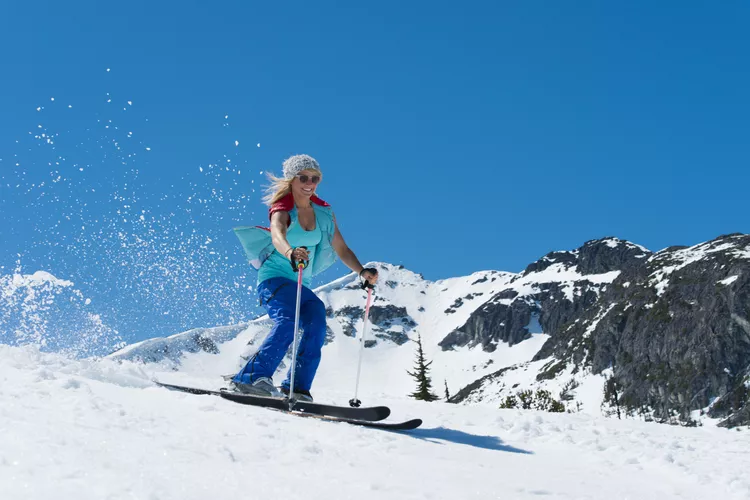1. Overview of Spring Skiing in Canada
2. Eastern Canada Ski Resorts
3. Interior Canada Ski Options
4. The Canadian Rockies
5. Western Canada Ski Destinations
Spring skiing is a popular activity at ski resorts throughout Canada. While most Eastern travelers head west in March to experience the breathtaking mountain ranges and deep snowpacks, many eastern resorts also offer the coveted corn-like conditions that skiers and snowboarders cherish. Spring skiing is particularly appealing because, although there’s snow atop the mountains, temperatures can be pleasantly warm, allowing for a unique skiing experience. However, it is important to note that March break for public schools in Canada and Reading Week for university students tend to be the busiest travel times, leading to longer lift lines. Nevertheless, fewer crowds, enticing package deals, and extended daylight hours make it worthwhile to conclude the ski season with an unforgettable experience.
Eastern Canada
Spring skiing is a less prominent phenomenon in Eastern Canada compared to resorts in the West, such as Whistler, Banff, or Revelstoke. Ski resorts in Eastern Canada, including those in Ontario and Quebec, generally have shorter ski seasons and lower alpine terrain. However, these resorts continually manufacture snow throughout the season, allowing trails to be skiable into late March and sometimes even April, especially during favorable snow years.
Various popular resorts in Ontario, Quebec, and some ski destinations in the Canadian Maritimes and Newfoundland provide spring ski deals in March and April that are significantly more affordable than those in the west. Therefore, if you do not require extreme elevation or an extensive journey to enjoy a family ski vacation, Eastern Canada—with resorts like Mont Tremblant, Mont Blanc, Le Massif, and Mont-Sainte-Anne—presents a compelling choice for spring skiing.
Interior Canada
The interior provinces of Saskatchewan and Manitoba boast an abundance of winter snow and ski resorts. For instance, Wapiti Valley Ski & Board Resort in Saskatchewan features 15 trails, multiple terrain parks, and an impressive elevation of 310 meters. They also offer night skiing once a month for those seeking adventure under the stars. Additionally, Table Mountain, located in Saskatchewan, provides night skiing and a Ski and Ride Camp during the March break.
Another notable option is the Asessippi Ski Area and Resort in Manitoba. This up-and-coming resort prides itself on offering the best snow sports facilities from Thunder Bay to Calgary. With 27 groomed runs that cater to beginners and experts alike, alongside one quad chair and two triple chairs, this interior Canadian resort doesn’t compromise on infrastructure. Don’t miss their annual Big Air Snowboard Championship held in mid-March.
The Canadian Rockies
While Whistler may receive significant attention, Lake Louise and Fernie arguably boast superior snow conditions. March is renowned for frequent storms in the Rockies that transform spring conditions into remarkable powder snow.
Alberta harbors three of the province’s biggest ski attractions: Lake Louise Mountain Resort, Sunshine Village, and Mt. Norquay. Collectively known as the “Big 3,” these resorts are located in Banff National Park, which is celebrated for its light and abundant powder snow conditions. Notably, Lake Louise and Sunshine Village enjoy extended spring ski seasons, remaining open until Victoria Day in May. Lake Louise, with over 4,200 skiable acres, ranks as one of the largest ski resorts in North America. After tackling all three resorts, consider rounding out your stay with a memorable dogsled adventure and wildlife viewing in the national park.
The Fernie Alpine Resort receives an impressive 11 meters (37 feet) of snow annually, ensuring plentiful snow conditions during spring. Renowned for its legendary powder, natural hot springs, and inviting small-town pubs, the community of Fernie, along with its friendly Canadian locals, may just make you feel at home.
Western Canada
Coastal British Columbia experiences mild spring temperatures, making skiing during this season particularly enjoyable. Located just two hours north of Vancouver, Whistler Blackcomb’s ski season can extend until June. However, it is advisable to check the weather before planning your trip, as spring rains and rising temperatures can impact snow conditions.
Grouse Mountain, conveniently situated just outside of the city, offers spring breakers the best of both worlds—excellent skiing and snowboarding conditions combined with vibrant city nightlife. The breathtaking views from the summit are complemented by a professionally designed ski and snowboard park, featuring 15 lighted runs available for night skiing.





